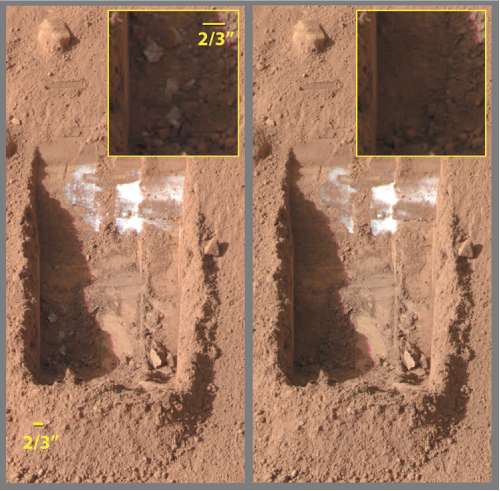It is still looking for little green men, but Nasa has taken a small step towards discovering life on Mars after its Phoenix Lander apparently exposed crumbs of ice under the soil of the Red Planet.
Photos show that eight specks of bright material uncovered when a trench was dug in the Martian arctic three days earlier had suddenly vanished. Scientists say this indicates that they were made up of water.
"These little clumps completely disappearing over the course of a few days, that is perfect evidence that it's ice," said Peter Smith, of the University of Arizona, Tuscon. "There had been some question of whether the bright material was salt. Salt can't do that."
According to the theory advanced by Mr Smith, lead scientist on the Nasa mission, the frozen water vanished in between the first and second set of photographs being taken because it had vaporised.
Phoenix landed on the north pole of Mars last month. Its robotic arm is being use to dig up soil samples – with the aim of determining whether the planet ever has been, or ever will be capable of sustaining life.
In 2002, the orbiting Mars Odyssey probe detected large quantities of hydrogen below the surface, indicating that water might even be present in sufficient amounts to sustain Nasa's long-term dream of sending humans there.
However, the recent Phoenix mission's initial soil sample failed to yield any evidence of water, even after being heated, leaving scientists concerned that they had landed in the wrong place. The probe is largely immobile, and is only expected to remain intact for 90 days. After that time, the arrival of winter is expected to coat it in frozen carbon dioxide, preventing the solar panels on its exterior from producing energy.
On Monday, amid mounting pressure to yield the Martian version of pay-dirt, Mr Smith ordered a two-inch-deep trench, dubbed Dodo-Goldilocks, to be dug. At the edge of the hole, eight bright spots appeared, each measuring less than an inch across. By Thursday, all eight had vanished. Scientists had blamed this on a process called sublimation, by which solid materials turn directly into gas without first becoming liquid. Although rare on Earth, it would happen to water on Mars because its atmosphere is so thin and cold.
Smith believes that his chunks of ice came from a large "parent ice body" hidden under the soil. Cynics will wonder, however, at the timing of his latest discovery. The $420m (£210m) project has been criticised as an extravagance in some quarters, and has suffered a string of minor mishaps.
On Tuesday, it emerged that engineers at Nasa's jet propulsion laboratory in Pasadena were working around the clock to fix a software problem in the Phoenix Lander's memory system. "We now understand what happened, and can fix it with a software patch, said Barry Goldstein, the project manager.
The discovery of water, complete with grainy pictures to apparently prove it, will placate those who consider the project to be a waste of money.
Subscribe to Independent Premium to bookmark this article
Want to bookmark your favourite articles and stories to read or reference later? Start your Independent Premium subscription today.


Join our commenting forum
Join thought-provoking conversations, follow other Independent readers and see their replies